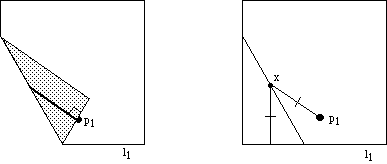"Solution" to exercise for axiom (O5)
I won't give the whole game away by drawing a picture, but the repeated use of axiom (O5) in this exercise will result in the appearance of a parabola on the paper. Really!
This should seem amazing - origami actually allows us to do simple calculus! Just one fold computes a tangent line of a parabola.
Exercise: Prove the above observation rigorously. (Hint: show that the envelope of all the crease lines is a parabola.)
But there's a more important thing to observe here. Parabolas are given by second degree equations. Thus axiom (O5) finds a point for us on some second degree equation. In other words, axiom (O5) solves second degree equations for us! It may seem strange to think of an origami fold as solving an equation, but mathematically this is exactly what is going on.
Back to Origami and Geometric Constructions